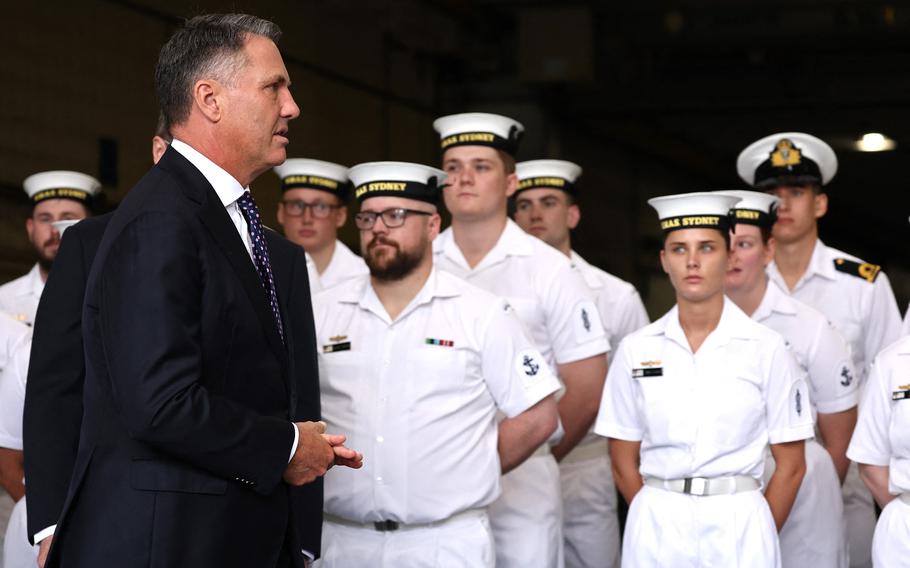
Australian Defense Minister Richard Marles walks past Royal Australian Navy sailors aboard the HMAS Canberra in Sydney on Feb. 20, 2024. (David Gray, AFP via Getty Images/TNS)
SYDNEY (Tribune News Service) — Australia plans to more than double the size of its naval combat fleet while scaling back the number of troubled BAE Systems Plc Hunter-Class frigates it builds, in a drive to meet the challenges in the Indo-Pacific region.
The government will increase warship funding in the May budget by $7.3 billion over the next decade, Defense Minister Richard Marles said Tuesday. The aim is to provide a larger and more lethal fleet that complements conventionally armed, nuclear-powered submarines.
Under the plan, released at the HMAS Kuttabul base in Sydney, the Navy will have 26 warships by the mid-to-late 2040s from the current 11, making it the country’s “largest fleet since the end of the Second World War,” according to Marles, who is also deputy prime minister. It will comprise:
Three upgraded Hobart class destroyers.
Six Hunter class frigates versus the previous nine.
11 new general purpose frigates that will progressively replace the six remaining Anzac class frigates.
Six new large operationally crewed surface vessels.
Australia, an open, trading island nation flanked by the Pacific and Indian Oceans, relies on secure sea lanes to move goods in and out of the country. The overhaul reflects an increasingly contested region amid China’s growing power.
The current fleet is the oldest the Navy has ever operated and the program released Tuesday called for immediate action to boost its air-defense, long-range strike, presence and anti-submarine warfare capabilities.
Tuesday’s announcement has been almost a year in the making. In April 2023, the center-left Labor government revealed the findings of a review into the military that found the defense forces were “not fully fit for purpose.”
As part of the government’s response to those findings, Marles announced a “short, sharp review” of Australia’s surface fleet led by former U.S. Adm. William H. Hilarides. It was his findings and the government’s view of them that were announced Tuesday.
The Hunter Frigates developed by BAE Systems were a particular focus, with Australian Broadcasting Corp. reporting that repeated delays and design problems with the vessels had pushed delivery of the first ship into the 2030s.
Nuclear subs
Simultaneously, Australia is working with the U.S. and U.K. to build and equip a fleet of nuclear-powered submarines for Canberra to field, potentially as early as the 2030s, as part of the Aukus agreement signed in 2021.
The 2023 defense review had recommended a greater emphasis on domestic manufacturing and Marles today reinforced that the plan involved a continuous shipbuilding program through the decades ahead.
South Australia and Western Australia will be the centerpieces of vessel construction, with the latter focused on the Henderson Naval precinct.
Western Australia, including the capital, Perth, is an important political battleground for the Labor government, which currently holds power with a majority of just two seats in the lower house of Parliament.
‘Off the shelf’
The government Tuesday highlighted that not only was it boosting the size of the fleet, it’s bringing forward the timeline. The first Hunter-Class frigate is still due in the early 2030s, but Australia will also purchase 11 general purpose frigates “off the shelf.”
The first of those will be delivered this decade and to ensure speed, quality and best price, the first three will be built abroad. Options considered include vessels from Spain, Germany, South Korea and Japan. A decision is anticipated next year.
“Australia’s modern society and economy rely on access to the high seas, trade routes for out imports and exports, and the submarine cables for the data which enables our connection to the international economy,” Marles said.
“The Royal Australian Navy must be able to ensure the safety and security of our sea lines of communication and trade routes.”
©2024 Bloomberg L.P.
Visit bloomberg.com.
Distributed by Tribune Content Agency, LLC.